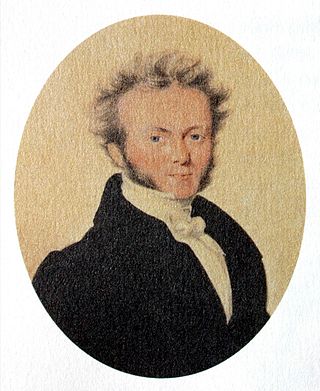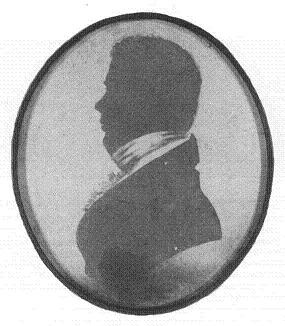Related Research Articles

The 1820s was a decade of the Gregorian calendar that began on January 1, 1820, and ended on December 31, 1829.

William John Burchell was an English explorer, naturalist, traveller, artist, and author. His thousands of plant specimens, as well as field journals from his South African expedition, are held by Kew Gardens, and his insect collection by the Oxford University Museum.
Lindsay Atkins Eddie FRAS was a South-African amateur astronomer, known for his observations of Venus, Mercury and Mars and 21 comets. He was elected a fellow of the Royal Astronomical Society in 1880. He saw active military service in South Africa and his final rank was that of a Major.

South African Astronomical Observatory (SAAO) is the national centre for optical and infrared astronomy in South Africa. It was established in 1972. The observatory is run by the National Research Foundation of South Africa. The facility's function is to conduct research in astronomy and astrophysics. The primary telescopes are located in Sutherland, which is 370 kilometres (230 mi) from Observatory, Cape Town, where the headquarters is located.

Sir Thomas Maclear was an Irish-born South African astronomer who became Her Majesty's astronomer at the Cape of Good Hope.

John Therry was an Irish Roman Catholic priest in Sydney, Australia.
The Vicariate Apostolic of Natal was a Roman Catholic missionary, quasi-diocesan jurisdiction in South Africa.

William Milne was the second Protestant missionary sent by the London Missionary Society to China, after his colleague, Robert Morrison. Milne served as pastor of Christ Church, Malacca, a member of Ultra-Ganges Mission, the first Principal of Anglo-Chinese College, and chief editor of two missionary magazines: Indo-Chinese Gleaner (English), and Chinese Monthly Magazine (察世俗每月統記傳). Due to Milne's distinguished role in his missionary field, the University of Glasgow granted him a Doctor of Divinity (D.D.) in 1820.

Lieutenant-Colonel Charles Collier Michell, KH, later known as Charles Cornwallis Michell, was a British soldier, first surveyor-general in the Cape, road engineer, architect, artist and naturalist.
Sir John Wylde was Chief Justice of the Cape Colony, Cape of Good Hope and a judge of the Supreme Court of the colony of New South Wales born at Warwick Square, Newgate Street, London.

Fearon Fallows was an English astronomer.
Johannes Ludwig Leopold Mund (1791-1831) and Louis Maire were natural history collectors who worked in the Cape Colony under the sponsorship of the Berlin Museum of Natural History. Museum specimens they collected were always labeled under the names, "Mund & Maire".

The Royal Observatory, Cape of Good Hope, is a former scientific institution in South Africa. Founded by the British Board of Longitude in 1820, its main building is now the headquarters building of the South African Astronomical Observatory.
Hadlow was a merchant sailing ship built in 1814 at Quebec, British North America. She made two voyages transporting convicts from England and Ireland to Australia. She plied between England, India, and Sierra Leone before being lost with all hands in 1823.
John Dowie Borthwick (1867–1936) was a veterinary surgeon in the Cape Colony.
Castle Forbes was a merchant ship built by Robert Gibbon & Sons at Aberdeen, Scotland in 1818. She was the first vessel built at Aberdeen for the trade with India. She then made several voyages to India, sailing under a license from the British East India Company (EIC). She made two voyages transporting convicts from Ireland to Australia. She sustained damage in 1826 on a voyage to India and was condemned at the Cape of Good Hope. However, she was repaired. She was last listed in 1832, and in 1838 in Lloyd's Register (LR).
King George was built on the Thames in 1783 as a West Indiaman. From 1817 she made four voyages as a whaler in the British southern whale fishery. She was condemned at Guayaquil in 1824 on her fifth.
Thomas Grimley (1821–1871) was an Irish-born priest and educator who served as Bishop of Cape Town, South Africa.
Sir Johannes Hendricus Meiring Beck, FRSE was a Cape and later South African physician and politician. He was a member of the Cape Colony delegation to the National Convention between 1908 and 1909, which led to the creation of the Union of South Africa, and held various memberships of medical-professional and scholarly bodies in South Africa and the British realm. He was an early occupier of the office of the Minister of Posts and Telegraphs in South Africa.
Skelton was launched in 1818 at Whitby. She made one notable voyage in 1820 to Australia, notable because her captain later published a detailed account with extensive economic, commercial, and other observational information about the Cape of Good Hope, Hobart Town, Port Jackson, and Rio de Janeiro. She later became a West Indiaman and was wrecked in 1828.
References
- ↑ Sources give Scully's middle name as either "Henry" or "Hurst".
- 1 2 Denis, Philippe (1 January 1998). "Patrick Griffith, first Catholic bishop in South Africa". The Dominican Friars in Southern Africa. Brill. p. 67. ISBN 978-90-04-32001-7 . Retrieved 3 January 2024.
- ↑ SC, Jael (26 December 2017). "In Search of South Africa's First Chapels". The Southern Cross. Retrieved 3 January 2024.
- ↑ Barr, Colin (1 November 2015). ""Hurrah for Old Ireland!": Irish Catholicism at the Cape of Good Hope". "Hurrah for Old Ireland!": Irish Catholicism at the Cape of Good Hope. McGill-Queen's University Press. p. 257. ISBN 978-0-7735-9734-1 . Retrieved 3 January 2024.
- 1 2 3 4 5 6 7 Plug, C. (24 September 2020). "S2A3 Biographical Database of Southern African Science". S2A3 Biographical Database of Southern African Science. Retrieved 3 January 2024.
- 1 2 Stokes, Clifford. "Catholic Church Celebrates 200 Years of Existence in Southern Africa". Symposium of Episcopal Conferences of Africa and Madagascar (SECAM). Archived from the original on 25 February 2021. Retrieved 3 January 2024.
- 1 2 3 4 5 6 Asiel (27 January 2018). "Early Church: Infighting in the 1820s and 30s". The Southern Cross. Retrieved 3 January 2024.
- ↑ "History". Archdiocese of Cape Town. 30 October 2013. Retrieved 3 January 2024.
- 1 2 3 4 5 6 Warner, Brian (1995). "Cape Residence". Royal Observatory, Cape of Good Hope 1820–1831: The Founding of a Colonial Observatory Incorporating a biography of Fearon Fallows. Springer Netherlands. pp. 37–86. ISBN 978-94-011-0139-4 . Retrieved 3 January 2024.